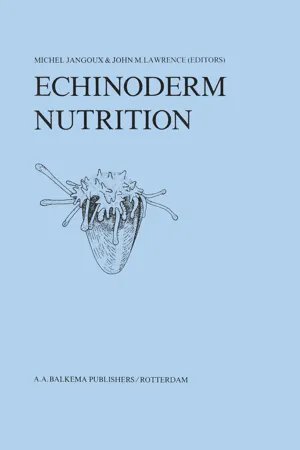
This is a test
- 700 pages
- English
- ePUB (mobile friendly)
- Available on iOS & Android
eBook - ePub
Echinoderm Nutrition
Book details
Book preview
Table of contents
Citations
About This Book
The purpose of this book is to present the state of knowledge concerning nutrition and point out directions for future work for the Echinodermata, an ancient group which shows great diversity in form and function, and whose feeding activities can have great environmental impact.
Frequently asked questions
At the moment all of our mobile-responsive ePub books are available to download via the app. Most of our PDFs are also available to download and we're working on making the final remaining ones downloadable now. Learn more here.
Both plans give you full access to the library and all of Perlego’s features. The only differences are the price and subscription period: With the annual plan you’ll save around 30% compared to 12 months on the monthly plan.
We are an online textbook subscription service, where you can get access to an entire online library for less than the price of a single book per month. With over 1 million books across 1000+ topics, we’ve got you covered! Learn more here.
Look out for the read-aloud symbol on your next book to see if you can listen to it. The read-aloud tool reads text aloud for you, highlighting the text as it is being read. You can pause it, speed it up and slow it down. Learn more here.
Yes, you can access Echinoderm Nutrition by Michel Jangoux,John M. Lawrence in PDF and/or ePUB format, as well as other popular books in Physical Sciences & Physics. We have over one million books available in our catalogue for you to explore.
1. FOOD AND FEEDING MECHANISMS
1
N. A. SLOAN & ANDREW C. CAMPBELL
PERCEPTION OF FOOD
The turbidity of inshore waters and the irregularity of much of the sea-bed limit the effectiveness of sight as a major sensory modality for many benthic marine invertebrates (Mackie 1975). Vision is, however, used extensively by a few specialised groups such as cephalopods (Wells 1978) and crustaceans (Waterman 1961, Hazlett 1972). Nicol (1967) did not consider that the ability to hear was widespread among marine invertebrates although some exceptions occur amongst the crustaceans (Salmon & Horch 1972, Meyer-Rochow & Penrose 1976). By contrast it seems that the transfer of information chemically either by contact or by water is particularly suitable for aquatic animals. Carthy (1958) pointed out that the usefulness of chemoreception is greatly enhanced when given directionality by current induced gradients. A further advantage is that only minute quantities of a chemical need be used to release a behavioural sequence (Lenhoff & Lindstedt 1974). Mackie & Grant (1974) among others, believed that chemoreception amongst marine invertebrates was a subject the importance of which ‘cannot be overemphasised’. Such awareness had not escaped earlier workers, for example Pearl (1903), who wrote ‘one of the most important factors in the sum total of activities of any aquatic organism is its reactions to chemical substances’.
Modern techniques, particularly in the realm of electrophysiology, have led to a more accurate analysis of the processes of transduction and integration of sensory activity in nervous systems, but as Ramsay (1968) pointed out, chemoreception appears to lag behind on research effort by comparison with other sensory modalities, e.g. vision. It is encouraging that more recently Lenhoff & Lindstedt (1974) indicated some improvement of the situation concerning chemoreception research methods and objectives so that the paradox of intensity of investigation on the one hand and biological significance on the other many be resolving (Kittredge et al. 1974). Concerning topics of inter-specific chemoreception in marine invertebrates generally, food detection has the best coverage (Passano 1957, Kohn 1961, Laverack 1963, Lindstedt 1971, Lenhoff & Lindstedt 1974). In a review of feeding, digestion and nutrition of all echinoderms, however, Ferguson (1969a) devoted only a very minor portion to ‘Chemosensitivity to food’, a measure of how poorly understood the field of echinoderm chemoreception has been.
1. CHEMORECEPTION IN ECHINODERMS RELATED TO THEIR STRUCTURE AND LIFE STYLE
Echinoderms have unusual anatomical arrangements linked with peculiar physiological and behavioural ones which have considerable effects upon food perception and feeding. The form of symmetry, especially in relation to the lack of a head, the distribution of sensory and nervous elements, and the distribution of locomotor units are of paramount importance.
There is little doubt that the first echinoderms were sedentary, if not sessile, suspension feeders (Nichols 1969). The water vascular system with its protrusible hydraulic tube-feet probably arose as a respiratory system which, because of its arrangement with respect to the mouth, allowed it to fulfil a food collecting role too (Nichols 1969), as in the crinoids. In such animals the pentameric plan is ideal and the lack of a head no disadvantage. Most remaining extant echinoderms have undergone major evolutionary advances. These include the inversion of their bodies with respect to the substrate and the assumption, in some cases, of a superficial bilateral symmetry. Such developments, however, have not led to the universal abandonment of suspension feeding. The inversion of the body allowed the water vascular system to take on an additional function, that of locomotion. Such slow moving or sedentary radially symmetrical animals can receive chemical stimuli emanating from all directions equally well. Moreover, a rounded or disc-like body widely covered with receptor units should provide an ideal mechanism for gross sensory perception and anal...
Table of contents
- Cover
- Half Title
- Title Page
- Copyright Page
- Contents
- Foreword
- Preface
- Part One: Food and Feeding Mechanisms
- Part Two: Digestive Systems
- Part Three: Physiology and Biochemistry
- Part Four: Nutrition During Development
- Part Five: Effects of Feeding on the Environment
- Bibliography
- List of contributors
- Species index
- Subject index